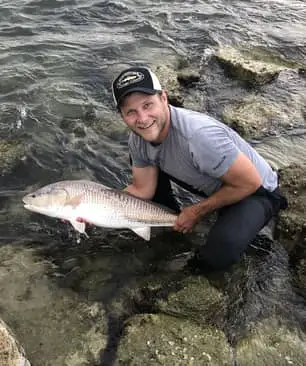Spanish mackerel are a predatory, semi-pelagic fish that inhabit Northern Atlantic coastal waters from Texas to Massachusetts.
Each year their habitat shrinks and expands in accordance with seasonal temperatures.
Spanish mackerel follow these temperature changes north and south throughout the year, passing through the waters of different states on their way.
Table of Contents
Spanish Mackerel Migration
Spend any amount of time on the fishing jetties and piers of the southeast, and you’ll likely hear anglers asking ‘When Do Spanish Mackerel Run?”.
This is just fisherman slang for, ‘When are the spanish mackerel gonna start showing up on the beaches and piers so we can catch them!’.
But, It is important to note that the Spanish mackerel run is a seasonal expansion of their natural range, rather than a migratory event.
Due to this, Spanish Mackerel may start the year in one location, and then travel to the next over the next few seasons! Generally speaking, Spanish Mackerel tend to run the most during the summer months.
And although spanish mackerel can be caught in many locations all year long, there are certain times of year when the fishing really picks up, as fish move closer inshore following bait.

Most migrations are for the purpose of breeding or finding food, while Spanish mackerel simply follow the expansion of warm water throughout the seasons.
Spanish Mackerel have two main migratory groups, the Atlantic group, ranging from southwest Florida to Massachusetts, and the Gulf of Mexico group, ranging from the Florida Keys to northern Texas.
I’ll focus on the locations of each of these groups separately since they make two different expansionary patterns.
Winter
At the beginning of the year from January to March, Spanish mackerel inhabit the southernmost part of their range.
Both groups will primarily be found in South Florida. If you live in Florida, the best time to target Spanish Mackerel is February through March.
Spring
From April to June Spanish mackerel begin moving northward out of their wintering grounds.
The Atlantic group moves into the waters of Georgia, South Carolina, and North Carolina, respectively. The best time to catch them in these states is as follows:
- Georgia and South Carolina: April through May
- North Carolina: May through July
At this time the Gulf group also starts to move northward and we see the first of them moving into Alabama and Mississippi.
Texas also gets good Spanish mackerel fishing in the spring due to western gulf populations moving north, with its peak being May and June.
Summer
The summer months are when Spanish mackerel move around the most, and when they reach the northernmost point in their habitat.

The Spanish mackerel still inhabit the more southern states, just in fewer numbers since they have spread out significantly.
During this time they will reach the Chesapeake Bay, hitting Virginia, Maryland, and Delaware, and move northward to New Jersey, New York, Connecticut, Rhode Island, and Southern Massachusetts. Here is when you can expect to see them show up:
- Virginia: June through August
- Maryland and Delaware: August through October
- New Jersey and northward: September and October
This is also the best time to catch Spanish mackerel in the northern Gulf of Mexico because they push upwards and then stay on the north side of the Gulf until fall. The best time to catch them in each state is:
- Alabama and Mississippi: June through August
- Louisiana: July and August
If you want to have better chances of attracting Spanish Mackerel to your pole, you should try using cut or live bait. For instance, frozen mullet bait is exceptionally good for catching Spanish Mackerel.
Fall
At this point, Spanish mackerel begin their journeys back down south.
They inhabit the same states that they did in the spring. This is a great time to get them in the Chesapeake Bay and the Carolinas, but the season begins to slow down as the water cools.
Some of the largest specimens can be caught in the fall due to them fattening up during the summer, but at this point, the bite starts to withdraw so you might have to put in some extra hours for that prized fish.
Conclusion
If you’re looking to catch some Spanish mackerel and you live on the east coast, you’re in luck! There’s most likely a season for you. Get to know how these fish travel and you’ll have no problem catching them when the time rolls around.
Related: When Do Bluefish Run? A State-By-State Breakdown.

Growing up in Florida, I’ve been surrounded by saltwater my entire life…and I love sharing my passion with others.
To learn more about why I started Saltwater Mecca, visit the ABOUT page.
Thank you for reading this article. Browse around & have some fun!